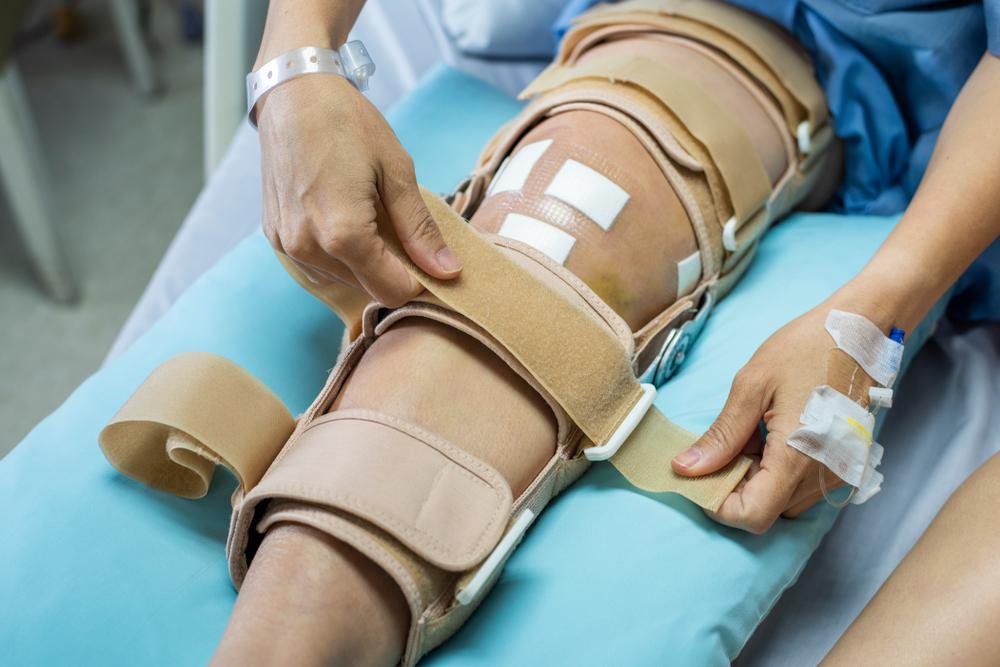 Your body has almost 1,000 ligaments that connect bones and joints together. Ligaments are strong bands of tissue that support the healthy movement of joints and stabilize muscles and bones. An injury to one or more ligaments in the body can cause pain, swelling, and instability in the area. A PCL injury refers to the posterior cruciate ligament (PCL), which is a ligament that runs along the back of your knee joint. The posterior cruciate ligament connects your femur, or thigh bone, to the tibia, or shinbone. Anyone can suffer from a PCL injury, though this type is especially common in athletes who participate in sports like baseball, football, soccer, and skiing. Here’s everything you need to know about the causes, symptoms, and treatment for PCL injuries.
Your body has almost 1,000 ligaments that connect bones and joints together. Ligaments are strong bands of tissue that support the healthy movement of joints and stabilize muscles and bones. An injury to one or more ligaments in the body can cause pain, swelling, and instability in the area. A PCL injury refers to the posterior cruciate ligament (PCL), which is a ligament that runs along the back of your knee joint. The posterior cruciate ligament connects your femur, or thigh bone, to the tibia, or shinbone. Anyone can suffer from a PCL injury, though this type is especially common in athletes who participate in sports like baseball, football, soccer, and skiing. Here’s everything you need to know about the causes, symptoms, and treatment for PCL injuries.
Anatomy of the Knee Joint
Did you know that the knee is actually the largest joint in your body? The knee is a hinge joint that allows you to bend and straighten your leg. This joint does have some flexibility by allowing slight rotation to either side. In each knee, you have four main ligaments that strengthen the knee joint and prevent the bones from dislocating. These ligaments support the forward bending and straightening of the knee. Your knee joint also relies on these ligaments to prevent your knee from moving backward or side to side. Tendons and ligaments help support and stabilize the knee, while muscles provide power and mobility. Cartilage covers the ends of the femur and tibia, which prevents the bones from rubbing against one another. Your kneecap, also known as the patella, is another bone that makes up the knee joint. A healthy knee absorbs everyday stress and allows for typical movements like standing, sitting, and walking without experiencing pain or discomfort.
PCL Sprains & Tears
The posterior cruciate ligament is the strongest ligament in your knee. You need the PCL to help keep your bones in place and allow for the knee to move smoothly. As the main stabilizer for your knee joint, the PCL also prevents your knee from rotating too far to either side or backward. The posterior cruciate ligament also helps ensure that your thigh bone and shinbone are properly aligned. A strain or tear to the PCL is known as a PCL injury. When you suffer an injury to the PCL, the symptoms can range from moderate discomfort to severe pain and an inability to bear weight on the knee joint. An injury to the PCL and knee will make typical movements more painful or unbearable until you receive proper treatment and care. A sprain refers to overstretching of a soft tissue like the posterior cruciate ligament. A sprained ligament may be overstretched or suffer a partial or complete tear. A PCL strain can cause pain and instability of the knee, ranging from mild to severe.
Causes of PCL Injuries
 Severe knee trauma is the most common cause of a PCL injury. Here are four examples of what might cause a PCL injury.
Severe knee trauma is the most common cause of a PCL injury. Here are four examples of what might cause a PCL injury.
Car Accidents
Drivers and front-seat passengers are at greater risk of a knee injury during a car accident. The force from the collision could cause your knees to collide with a hard surface like your car’s dashboard. A hard blow to the front of your knee can put too much pressure on the ligaments and other tissues that support your knee, leading to an injury like a sprained or torn PCL. A car accident could also lead to a dislocation of your knee joint, which can put additional stress on nearby soft tissues like the PCL. If you suffer a PCL car accident injury, you may notice pain, redness, bruising, and swelling in the affected knee.
Sports Collisions
High contact sports can also put you at greater risk for a PCL injury. Athletes who play sports like football or soccer could tear the posterior cruciate ligament if they collide with another player and take a hard hit to the knee. Baseball and basketball players could also suffer a PCL injury if they land incorrectly from a jump or fall onto a bent knee. A sudden hit to the front of the knee can cause the knee to bend too far backward, which can overstretch or tear the posterior cruciate ligament.
Slip & Fall
Accidents happen, and a sudden slip or trip could lead to a painful injury that affects the ligaments in your knee. When you do not have enough time to brace yourself for a fall, you could land hard onto bent knees, which can send a jolt of pressure into the knee. You might trip while walking up some stairs and hit your knee on a hard surface. A fall down the stairs or tripping on an uneven surface could cause you to twist your knee outside of its typical forward motion and sprain or tear the PCL and other tissues that support the joint.
Symptoms of a PCL Injury
Symptoms of posterior cruciate ligament injuries can vary depending on the location and severity of the injury. The most common symptoms of a PCL injury include pain, swelling, and instability in the knee. Pain can range from mild to severe depending on whether you have suffered a mild sprain or a full tear of the PCL. A PCL injury can also occur along with injuries to other ligaments that support the knee, making your pain and discomfort worse. A sudden blow to the knee will typically result in bruising in the area, and you may notice redness and that the skin around your knee becomes warm to the touch. Swelling and inflammation of the knee can cause more pain and make it difficult for you to bend or straighten your knee. A moderate to severe PCL injury can cause difficulty walking or going down a flight of stairs. When your knee feels unstable, you might worry about putting too much weight on the knee. Because a PCL injury can cause you to restrict movement of your knee, you may notice an increase in stiffness and soreness in and around the knee.
PCL Injury Treatments
 Visit your Atlanta doctor for a proper diagnosis of your PCL injury and learn more about the extent of the damage. Your doctor will likely perform a physical examination of the knee and test your range of motion. They will want to hear about what symptoms you have been experiencing and what movements or activities have made your symptoms better or worse. Diagnostic imaging tests like X-rays or CT scans can also help to confirm a PCL injury and rule out other potential injuries with similar symptoms. Once your doctor has confirmed a PCL injury, they will talk to you about your options for treatment. These are three examples of PCL injury treatments you may experience.
Visit your Atlanta doctor for a proper diagnosis of your PCL injury and learn more about the extent of the damage. Your doctor will likely perform a physical examination of the knee and test your range of motion. They will want to hear about what symptoms you have been experiencing and what movements or activities have made your symptoms better or worse. Diagnostic imaging tests like X-rays or CT scans can also help to confirm a PCL injury and rule out other potential injuries with similar symptoms. Once your doctor has confirmed a PCL injury, they will talk to you about your options for treatment. These are three examples of PCL injury treatments you may experience.
Self-Care
For mild PCL injuries, you may be able to manage your pain and other symptoms with home remedies and self-care. Resting the area will help remove pressure from the knee so the healing can begin. Icing your affected knee will help bring down any swelling and inflammation in the area. Your doctor may recommend an elastic bandage or knee brace to provide gentle compression and support for any instability while you heal. Elevating your knee above your heart can also help reduce blood flow to the area, reducing swelling. Over-the-counter pain relievers like non-steroidal anti-inflammatory drugs may help address inflammation, swelling, and pain.
Non-Invasive Options
Depending on the severity of your PCL injury, your doctor may suggest non-invasive treatment options to help you heal. You may need to use crutches for a certain period of time, which can help you take the weight off the affected knee. A knee brace can also help with swelling and addressing instability, so you do not risk further spraining or tearing the ligament. A physical therapist can also work with you to help strengthen and stabilize your knee. If necessary, physical therapy stretches and exercises can help you regain mobility after surgery.
Surgical Options
A severe PCL injury may require surgery for a full recovery. The most common surgery for a PCL injury is called a knee arthroscopy, where a surgeon will reconstruct the ligament. This is a less invasive surgical option where the surgeon makes small incisions around the knee and uses tiny surgical tools to repair or remove any damaged tissue. On average, recovery from a knee surgery can take 6 to 9 months, so you want to talk with your doctor about all your treatment options.
Visit AICA Orthopedics in Atlanta and meet with a knee doctor to find out what type of treatment for your PCL injury is right for you. Our team of doctors has access to state-of-the-art diagnostic equipment in the office, and you can meet with your doctor and a physical therapist all in one convenient location. We will also work with you to help reduce your risk and prevent posterior cruciate ligament injuries in the future.
